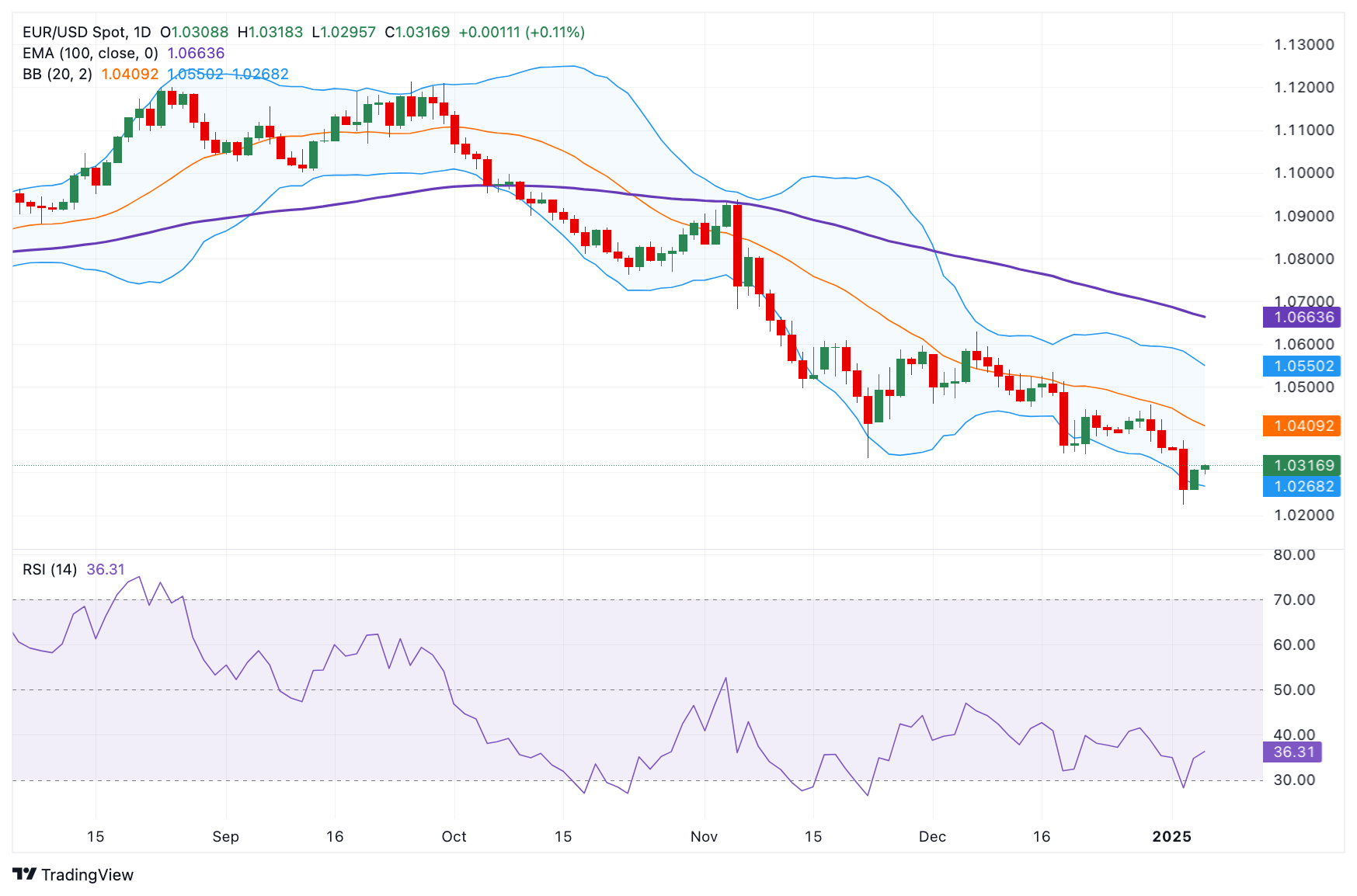- EUR/USD drifts lower to around 1.0315 in Monday’s early European session.
- The negative view of the pair prevails below the 100-day EMA with the bearish RSI indicator.
- The initial support level is seen at 1.0267; the immediate resistance level to watch is 1.0458.
The EUR/USD pair weakens to near 1.0315 during the early European session on Monday. The expectation that the European Central Bank (ECB) will further cut the interest rate this year undermines the Euro (EUR) against the Greenback. Later on Monday, investors will take more cues from the Eurozone HCOB Composite Purchasing Managers’ Index (PMI) and the preliminary reading of German Consumer Price Index (CPI) data for December.
Technically, the bearish outlook of EUR/USD remains in play as the major pair remains capped below the key 100-day Exponential Moving Average (EMA) on the daily chart. Furthermore, the downward momentum is supported by the 14-day Relative Strength Index (RSI), which is located below the midline around 35.90, suggesting that the path of least resistance is to the downside.
The lower limit of the Bollinger Band at 1.0267 acts as an initial support level for the major pair. A decisive break below the mentioned level could expose the 1.0200 level. Further south, the next contention level is seen at 1.0160, the low of August 8, 2022.
On the bright side, the first upside barrier for EUR/USD emerges at 1.0458, the high of December 30. Sustained trading above this level could pave the way to 1.0550, the upper boundary of the Bollinger Band. Extended gains could see the next hurdle at 1.0663, the 100-day EMA.
EUR/USD daily chart

Euro FAQs
The Euro is the currency for the 19 European Union countries that belong to the Eurozone. It is the second most heavily traded currency in the world behind the US Dollar. In 2022, it accounted for 31% of all foreign exchange transactions, with an average daily turnover of over $2.2 trillion a day. EUR/USD is the most heavily traded currency pair in the world, accounting for an estimated 30% off all transactions, followed by EUR/JPY (4%), EUR/GBP (3%) and EUR/AUD (2%).
The European Central Bank (ECB) in Frankfurt, Germany, is the reserve bank for the Eurozone. The ECB sets interest rates and manages monetary policy. The ECB’s primary mandate is to maintain price stability, which means either controlling inflation or stimulating growth. Its primary tool is the raising or lowering of interest rates. Relatively high interest rates – or the expectation of higher rates – will usually benefit the Euro and vice versa. The ECB Governing Council makes monetary policy decisions at meetings held eight times a year. Decisions are made by heads of the Eurozone national banks and six permanent members, including the President of the ECB, Christine Lagarde.
Eurozone inflation data, measured by the Harmonized Index of Consumer Prices (HICP), is an important econometric for the Euro. If inflation rises more than expected, especially if above the ECB’s 2% target, it obliges the ECB to raise interest rates to bring it back under control. Relatively high interest rates compared to its counterparts will usually benefit the Euro, as it makes the region more attractive as a place for global investors to park their money.
Data releases gauge the health of the economy and can impact on the Euro. Indicators such as GDP, Manufacturing and Services PMIs, employment, and consumer sentiment surveys can all influence the direction of the single currency. A strong economy is good for the Euro. Not only does it attract more foreign investment but it may encourage the ECB to put up interest rates, which will directly strengthen the Euro. Otherwise, if economic data is weak, the Euro is likely to fall. Economic data for the four largest economies in the euro area (Germany, France, Italy and Spain) are especially significant, as they account for 75% of the Eurozone’s economy.
Another significant data release for the Euro is the Trade Balance. This indicator measures the difference between what a country earns from its exports and what it spends on imports over a given period. If a country produces highly sought after exports then its currency will gain in value purely from the extra demand created from foreign buyers seeking to purchase these goods. Therefore, a positive net Trade Balance strengthens a currency and vice versa for a negative balance.
Information on these pages contains forward-looking statements that involve risks and uncertainties. Markets and instruments profiled on this page are for informational purposes only and should not in any way come across as a recommendation to buy or sell in these assets. You should do your own thorough research before making any investment decisions. FXStreet does not in any way guarantee that this information is free from mistakes, errors, or material misstatements. It also does not guarantee that this information is of a timely nature. Investing in Open Markets involves a great deal of risk, including the loss of all or a portion of your investment, as well as emotional distress. All risks, losses and costs associated with investing, including total loss of principal, are your responsibility. The views and opinions expressed in this article are those of the authors and do not necessarily reflect the official policy or position of FXStreet nor its advertisers. The author will not be held responsible for information that is found at the end of links posted on this page.
If not otherwise explicitly mentioned in the body of the article, at the time of writing, the author has no position in any stock mentioned in this article and no business relationship with any company mentioned. The author has not received compensation for writing this article, other than from FXStreet.
FXStreet and the author do not provide personalized recommendations. The author makes no representations as to the accuracy, completeness, or suitability of this information. FXStreet and the author will not be liable for any errors, omissions or any losses, injuries or damages arising from this information and its display or use. Errors and omissions excepted.
The author and FXStreet are not registered investment advisors and nothing in this article is intended to be investment advice.
Recommended content
Editors’ Picks

Gold pulls away from record-high set above $3,000
Gold corrects lower and trades below $2,990 in the American session after setting a new record-high above $3,000 earlier in the day. Rising US Treasury bond yields and the improving risk mood seems to be limiting XAU/USD's upside.

EUR/USD clings to daily gains above 1.0850 after US data
EUR/USD stays in positive territory above 1.0850 in the American session on Friday. Disappointing consumer sentiment data from the US makes it difficult for the US Dollar (USD) to find demand and helps the pair hold its ground heading into the weekend.

GBP/USD stays below 1.2950 despite weak US sentiment data
GBP/USD struggles to gather recovery momentum and trades in negative territory below 1.2950 in the American session, despite the broad-based USD weakness. Earlier in the day, disappointing GDP data from the UK weighed on Pound Sterling, dragging the pair lower.

US SEC may declare XRP a 'commodity' as Ripple settlement talks begins
The US SEC is considering declaring XRP as a commodity in the ongoing settlement talks with Ripple Labs. FOX News reports suggest Ethereum's regulatory status remains a key reference for XRP’s litigation verdict.

Week ahead – Central banks in focus amid trade war turmoil
Fed decides on policy amid recession fears. Yen traders lock gaze on BoJ for hike signals. SNB seen cutting interest rates by another 25bps. BoE to stand pat after February’s dovish cut.

The Best brokers to trade EUR/USD
SPONSORED Discover the top brokers for trading EUR/USD in 2025. Our list features brokers with competitive spreads, fast execution, and powerful platforms. Whether you're a beginner or an expert, find the right partner to navigate the dynamic Forex market.